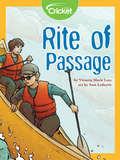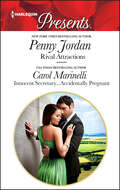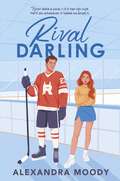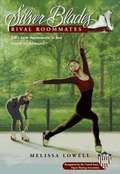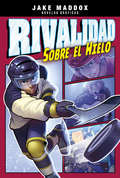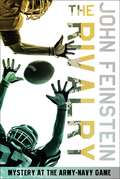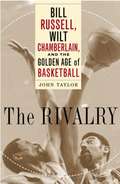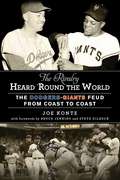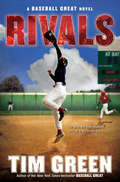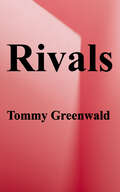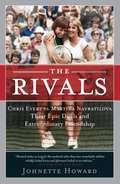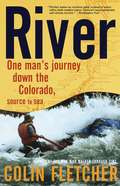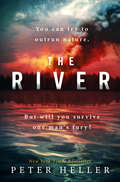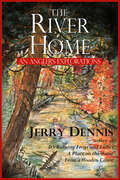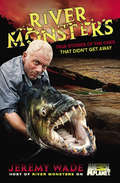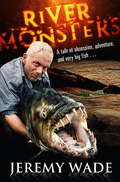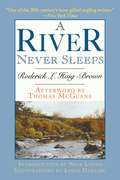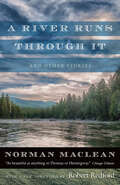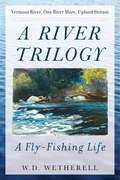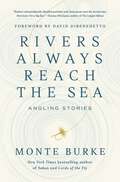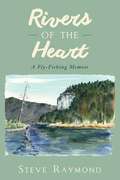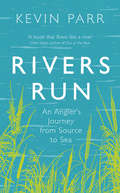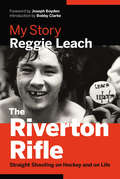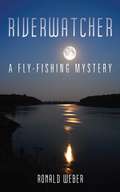- Table View
- List View
Rite of Passage
by Victoria Marie LeesSuccessful two-man canoeing requires teamwork. Cousins Ben and Jude must learn to work together to avoid a disaster on the Delaware River.
Rival Attractions and Innocent Secretary . . . Accidentally Pregnant
by Penny Jordan Carol MarinelliRediscover this classic romance RIVAL ATTRACTIONS by New York Times bestselling authorPenny JordanCharlotte Spencer won't allow herself to trust charming tycoon Oliver Tennant. How canshe give in to their heated attraction when he's her business rival? Oliver soondetermines to get under mysterious Charlotte's skin. But even he doesn't expect thefireworks when these boardroom enemies become bedroom lovers… Originally published in 1990And enjoy reader-favorite INNOCENT SECRETARY, ACCIDENTALLY PREGNANT by USA Todaybestselling author Carol Marinelli Plain Emma Stephenson might not look like a tycoon's assistant, but for playboy Luca D'Amato breaking through her no-nonsense exterior is hisfavorite new game! Sensible Emma thought they'd be sharing an office—not a bed! But nowshe must find the words to tell him…she's pregnant! Originally published in 2009
Rival Darling (The Darling Devils #1)
by Alexandra MoodyAlexandra Moody's YA ice hockey rom-com—the first of the BookTok sensation Darling Devils series—will warm your heart!She has a (fake) date with a Devil . . .When Violet is left heartbroken by the captain of her school’s ice hockey team, she vows never to date a jock again. But to prove she’s moved on, she turns to the most unlikely person: her ex’s biggest rival, the notorious captain of the Ransom Devils.Reed Darling is gorgeous, mysterious, and intimidating—the only thing people love to talk about more than his hockey skills are his exploits as a ruthless heartbreaker and bad boy. Who better to serve as Violet’s fake boyfriend until her ex gets the message, right?But Violet soon starts to wonder if there’s more to Reed than the gossip suggests. And Reed is determined to win her over and show her he’s not the guy everyone thinks he is. Is this jock about to break all her rules?
Rival Roommates (Silver Blades, #21)
by Melissa LowellJill can't believe it! Her new roommate at the Ice Academy is Carla Benson--an old rival from another skating club. Carla and Jill are constantly competing over something. But then can Jill stop Carla from stealing her new boyfriend, Josh?
Rivalidad sobre el hielo (Jake Maddox Novelas gráficas)
by Jake MaddoxJackson "Jax" Kingsford is a skilled hockey player with a wicked slapshot. When his team makes it to the state hockey tournament, he can't believe that he has to play against his former best friend, Archer Voss. The two were once inseparable and loved playing hockey together, both in Jax's backyard and on the school's hockey team. But then Archer's family had to move, splitting up the team and causing a fall out in their friendship. What will happen when the former friends face off against each other in the big game? Combining a high-stakes sports story with a dynamic full-color comic format, this Jake Maddox Graphic Novel is sure to be a win for young athletes and struggling readers alike. Fully translated Spanish text.
The Rivalry: Mystery at the Army-Navy Game (Final Four Mystery #5)
by John FeinsteinBestselling writer John Feinstein is back with another exciting sports-mystery, this one set behind the scenes at the storied Army-Navy football game.Teen sportswriters Stevie Thomas and Susan Carol Anderson are thrilled to be covering "America's Game." The Black Knights of Army and the Midshipmen of Navy have met on the football field since 1890, and it's a rivalry like no other, filled with tradition. But this year, the match-up is also filled with intrigue.For weeks, Stevie and Susan Carol have been spending time at Annapolis and West Point, getting to know the players, and coaches. And the secret service agents. Since the president will be attending the game, security will, of course, be tighter than tight. As the game draws nearer Stevie and Susan Carol can tell that the agents are getting tenser. But as usual when Stevie and Susan Carol cover a big event--nothing is quite as it seems, and the coaches aren't the only ones calling plays...From the Hardcover edition.
The Rivalry: Bill Russell, Wilt Chamberlain, and the Golden Age of Basketball
by John TaylorA BRILLIANTLY WRITTEN ACCOUNT OF THE NBA'S GLORY DAYS, AND THE RIVALRY THAT DOMINATED THE ERA. In the mid-1950s, the NBA was a mere barnstorming circuit, with outposts in such cities as Rochester, New York, and Fort Wayne, Indiana. Most of the best players were white; the set shot and layup were the sport's chief offensive weapons. But by the 1970s, the league ruled America's biggest media markets; contests attracted capacity crowds and national prime-time television audiences.
The Rivalry Heard 'Round the World: The Dodgers-Giants Feud from Coast to Coast
by Steve Dilbeck Joe Konte Bruce JenkinsGames between the Dodgers and Giants are never just another day at the ballpark. Dating back to the late nineteenth century--when the teams embodied the competitive spirit of rival metropolises of New York and Brooklyn--the Giants-Dodgers rivalry gained intensity throughout the early twentieth century. The cheering and jeering continued unabated until 1957, when the clubs backed the moving vans up to the Polo Grounds and Ebbets Field, and took their rivalry to new venues in Los Angeles and San Francisco. Indeed, Brooklyn-New York baseball was a tough act to follow, but the West Coast version didn't take long to fire up the emotions. Only six games into the first West Coast season, the clubs had their first beanball dustup. The venue had changed but the venom remained, and the rivalry became author Joe Konte's obsession. Fifty-five years ago, he attended one of the first Giants-Dodgers games ever played outside of New York. A longtime newspaper editor and baseball fiend, Konte understands what is so special about what is one of the most significant rivalries in American sports. And so--via statistical analysis, game summaries, roster scrutiny, manager matchups, season recaps, and more--he has put together a rivalry bible. Focusing primarily on the California years, but also providing background on the origins and the New York years, The Rivalry Heard 'Round the World captures the spirit and intensity of one of the greatest rivalries in American sports.
Rivals
by Tim GreenCooperstown! Josh is thrilled when all his hard training pays off in a big way and his team, the Titans, makes it to a national tournament in Cooperstown, home of the National Baseball Hall of Fame. More is on the line for Josh than just a trophy. Winning would mean everything to his dad-now Josh's coach. Winning could mean a major endorsement deal for the Titans and the attention of big league scouts! After a dirty play and a brutal injury threaten to sideline Josh, he spies suspicious activity at the tournament. He tries to tell his good friend Jaden about what he's seen, but she's too busy spending time with the L.A. Comets' star player, Mickey Mullen Jr., to want to get involved. Jaden says she's doing research for the newspaper . . . but is she? Now Josh has a rival-both on the field and off-as he swings for the fences in a game that quickly becomes more dangerous. New York Times bestselling author Tim Green delivers a hard-hitting look at what some teams will do to win in this gripping companion to Baseball Great.
Rivals
by Tommy GreenwaldFrom the author of the award-winning Game Changer comes a gripping novel about two student-athletes searching for stardom, a young reporter searching for the truth, and a crosstown basketball rivalry that goes too far. <p><p> The people of Walthorne love their basketball—and one of the things they love most is the special rivalry between the Walthorne North Middle School Cougars and the Walthorne South Middle School Panthers. <p><p>As the season begins, two star players are feeling the heat: Austin Chambers, captain of Walthorne North, worries that he's not good enough to live up to his father's legacy, while across town, the brilliantly talented Carter Haswell, captain of Walthorne South, is already under pressure to get a scholarship that might ease his family's financial stress. While both boys do whatever they can to make sure their team wins, Alfie Jenks, a school sports reporter, discovers that behind-the-scenes scandals are just as much a part of youth sports as on-the-court action. <p><p>When she blows the story wide open, the whole season is jeopardized. Told through a series of flashbacks, newspaper reports, social media posts, and interviews, Rivals will have readers tearing through the pages to see what happens next—and asking themselves if winning has become more important than doing the right thing.
The Rivals: Their Epic Duels and Extraordinary Friendship
by Johnette Howardn March 1973 two women met on a tennis court in Akron, Ohio. Over the course of the next sixteen years, together they would change the world. In their long careers Martina Navratilova and Chris Evert played each other eighty times, sixty of those in finals. For twelve consecutive years, from 1975 to 1986, one or other finished the season ranked No. 1 in the world. Each set out to be the finest player women's tennis had ever seen; each goaded the other to greatness. Their contrasting styles - Martina, the epitome of serve-and-volley tennis, bravely charging to the net against cool and controlled Chris, the world's greatest baseline player - captivated millions across the globe. Tennis was a chauvinistic game when they arrived. But their brilliance demanded, and received, long-overdue respect for female sporting achievement. Their ability to forge a close friendship amidst their fierce competition still provokes wonder and admiration from fans. There has never been a sporting rivalry to match the intensity, longevity, public impact and emotional resonance of the years-long duel between these two great athletes. For nearly two decades we were transfixed by the struggle between the ice-maiden Chris - blonde, all-American, a nation's sweetheart - and the supreme athlete Martina, a Czech defector, the first outspoken openly gay athlete in female sport, and a woman who wore her heart on her sleeve at all times. Their lockstep careers played out against the backdrop of seismic change in sport and society: the women's movement; the gay rights' movement; the fall of the Iron Curtain; and the rise of women's tennis from backwater to big time (with a huge nod of gratitude to Billie Jean King). Thirty years on from the first meeting, both have become legends. Based on interviews with both Martina and Chris and those who knew them best, Johnette Howard gives us the story of these two remarkable women. Brilliantly researched, beautifully written, The Rivals will be read by those who love sport for years to come.
River: One Man's Journey Down the Colorado, Source to Sea (Vintage Departures)
by Colin FletcherAt age sixty-seven, Colin Fletcher, the guru of backpacking in America, undertook a rigorous six-month raft expedition down the full length of the Colorado River--alone. He needed "something to pare the fat off my soul. . . to make me grateful, again, for being alive. " The 1,700 miles between the Colorado's source in Wyoming and its conclusion at Mexico's Gulf of California contain some of the most spectacular vistas on earth, and Fletcher is the ideal guide for the terrain. As his privileged companions, we travel to places like Disaster Falls and Desolation Canyon, observe beaver and elk, experience sandstorms and whitewater rapids, and share Fletcher's thoughts on the human race, the environment, and the joys of solitude.
The River: 'An urgent and visceral thriller... I couldn't turn the pages quick enough' (Clare Mackintosh)
by Peter HellerONE OF THE OBSERVER THRILLERS OF THE YEAR: 'GLORIOUS PROSE AND RAZOR-SHARP TENSION' 'LYRICAL AND ACTION-PACKED' Guardian'I COULDN'T TURN THE PAGES FAST ENOUGH' Clare Mackintosh'IMPOSSIBLE TO PUT DOWN, OR FORGET' Sunday Mirror'GLORIOUS DRAMA AND LYRICAL FLAIR Denise Mina, New York TimesTwo friends Wynn and Jack have been best friends since their first day of college, brought together by their shared love the great outdoors.The adventure of a lifetime When they decide to canoe down the Maskwa River in northern Canada, they anticipate the ultimate wilderness experience: no phones, no fellow travellers, no way of going back. A wild ride But as a wildfire starts to make its way towards them, their trip becomes a desperate race for survival. And when a man suddenly appears, claiming his wife has vanished, the fight against the raging flames becomes a much deadlier game of cat and mouse.
The River Home: An Angler's Explorations
by Jerry DennisIn this remarkable collection of essays and stories, winner of the Best Book of the Year Award from the Outdoor Writers Association of America, Jerry Dennis demonstrates why he has emerged as one of America's finest writers on nature and the outdoors. In prose that has drawn comparisons with John Voelker, Sigurd Olson, and Aldo Leopold, Dennis celebrates the simple pleasures and complex challenges of family life, the allure of giant trout, the sacredness of secret places, and such wonders as bad weather, quirky fishing companions, and the occasional naked angler. Ranging from northern Michigan to Iceland, Chile, and the fabled rivers of the American West, The River Home is a passionate record of a life lived fully, crafted with clarity, insight, and good humor—by a writer gifted with an instinct for what matters. PRAISE:"This bright and sharply written book is a guide to a life lived consciously, a prerequisite and bonus of the sport done well." —Lisa Faye Kaplan, USA Today&“Collections of essays about the outdoors and fishing crowd the shelves, but Dennis&’s fresh writing and marvelous insights merit special attention. This fine collection will appeal to fans of Hal Borland, W.D. Wetherell, and Nick Lyons, as well as to those who enjoy the essays of fiction writers William Tapply and Thomas McGuane.&” —Booklist&“Even if you&’ve never pulled on a pair of waders, you should read this funny and wise book about fly fishing – and a lot more.&” —Georgia Times-Union&“In this book, Dennis elevates the typical &‘outdoor&’ essay, usually a mere recollection of adventures while hunting, fishing, camping, canoeing, or pursuing other outdoor activities. He has transcended the typical by blending in elements of &‘nature&’ writing: observation, research, speculation about the world in which the sportsman places himself.&” —The Oakland Press
River Monsters: True Stories of the Ones that Didn't Get Away
by Jeremy WadeI’m Jeremy Wade, biologist and fishing detective. For twenty-five years, I’ve explored our planet’s remotest rivers and lakes, hunting for monster-sized fish. It’s become something of an obsession for me. . . . Called “the greatest angling explorer of his generation” (Independent on Sunday), Jeremy Wade, host of Animal Planet’s wildly popular TV series River Monsters, takes viewers where no wildlife program has gone before, revealing the creatures that lurk in the murky depths of our planet’s inland waterways. Now, Wade goes truly beneath the surface, disclosing full details of how he tracks down and catches each species while also recounting the off-camera highlights of his extraordinary life. From his arrest as a suspected spy in Southeast Asia to a plane crash in the Amazon, every page of River Monsters is packed with adventure. Each chapter unfolds an enthralling detective story, where fishermen’s tales of underwater man-eaters and aquatic killers are subjected to scientific scrutiny. Follow Wade step-by-step as, armed with just a fishing line, he closes in on his prey and separates fact from fiction. From the heart of the Congo, where he wrestles with supernatural goliath tigerfish, to the depths of the Amazon, where the most feared creature is one that could fit in your palm, the results are fish of staggering proportions and terrifying demeanor. Wade also reveals monsters from upcoming episodes, including deadly electric eels, a giant described as a cross between a shark and a chainsaw, and a snake-like beast that truly is the stuff of legend. In the tradition of the most gripping adventure writing, River Monsters shows that there’s more to this world than what’s visible on the surface. As Wade says, with a fishing line anything is possible-sometimes it can even reveal the future, or at least one possible version of it. In similar fashion, Wade’s writings are much more than exhilarating stories: they reveal a vision of the world more awe-inspiring than any individual myth made flesh. Ultimately, River Monsters explores the real mysteries that still exist, capturing the story of one man’s obsession-and his relentless pursuit of the truth.
River Monsters
by Jeremy WadeA tale of obsession and very big fish from Jeremy Wade, the presenter of ITV's RIVER MONSTERS.Over ten feet long, it weighs in at nearly a quarter of a ton. Covering its back are armoured plates made of bone. Five hundred stiletto-sharp teeth line its long crocodilian jaws. It's a prehistoric beast of staggering proportions; a fearsome creature from the time of the dinosaurs.But the Alligator Gar, an air-breathing survivor from the Cretaceous period is still with us today, patrolling inland rivers, hunting in murky waters shared by human communities.And for Jeremy Wade, described as the 'greatest angling explorer of his generation', the Gar and other outlandish freshwater predators have been an obsession for all his adult life. With names like Arapaima, Snakehead, Goonch, Goliath Tigerfish and Electric Eel, many of them have acquired an almost mythical status.In a quest that has taken him from the Amazon to the Congo, and from North America to the mountains of India, Wade has pursued the truth about these little known, often misunderstood animals. Along the way he's survived a plane crash, malaria and a fish-inflicted blow to the chest that, according to a later scan, caused permanent scarring to his heart.In RIVER MONSTERS, Wade delivers a sometimes jaw-dropping blend of adventure, natural history, legend and detective work. It reads like a hunt for the Loch Ness Monster. But it's all true. These are fisherman's tales like you've never heard before. The stories of the ones that didn't get away ...
A River Never Sleeps
by Thomas Mcguane Nick Lyons Louis Darling Roderick L. Haig-BrownFew books have captured the haunting world of music and rivers and of the sport they provide as well as A River Never Sleeps. Roderick L. Haig-Brown writes of fishing not just as a sport, but also as an art. He knows moving water and the life within it-its subtlest mysteries and perpetual delights. He is a man who knows fish lore as few people ever will, and the legends and history of a great sport.Month by month, he takes you from river to river, down at last to the saltwater and the sea: in January, searching for the steelhead in the dark, cold water; in May, fishing for bright, sea-run cutthroats; and on to the chilly days of October and the majestic run of spawning salmon. All the great joy of angling is here: the thrill of fishing during a thunderstorm, the sight of a river in freshet or a river calm and hushed, the suspense of a skillful campaign to capture some half-glimpsed trout or salmon of extraordinary size, and the excitement of playing and landing a momentous fish.A River Never Sleeps is one of the enduring classics of angling. It will provide a rich reading experience for all who love fishing or rivers.
River Parade
by Alexandra DayWhen a young boy goes for a boat ride on the river and accidentally falls in, he finds that swimming is not as scary as he expected.
A River Runs through It and Other Stories
by Norman MacLeanThe New York Times–bestselling classic set amid the mountains and streams of early twentieth-century Montana, “as beautiful as anything in Thoreau or Hemingway” (Chicago Tribune).When Norman Maclean sent the manuscript of A River Runs Through It and Other Stories to New York publishers, he received a slew of rejections. One editor, so the story goes, replied, “it has trees in it.” Today, the title novella is recognized as one of the great American tales of the twentieth century, and Maclean as one of the most beloved writers of our time. The finely distilled product of a long life of often surprising rapture—for fly-fishing, for the woods, for the interlocked beauty of life and art—A River Runs Through It has established itself as a classic of the American West filled with beautiful prose and understated emotional insights.Based on Maclean’s own experiences as a young man, the book’s two novellas and short story are set in the small towns and mountains of western Montana. It is a world populated with drunks, loggers, card sharks, and whores, but also one rich in the pleasures of fly-fishing, logging, cribbage, and family. By turns raunchy and elegiac, these superb tales express, in Maclean’s own words, “a little of the love I have for the earth as it goes by.”“Maclean’s book—acerbic, laconic, deadpan—rings out of a rich American tradition that includes Mark Twain, Kin Hubbard, Richard Bissell, Jean Shepherd, and Nelson Algren.” —New York Times Book ReviewIncludes a new foreword by Robert Redford, director of the Academy Award–winning film adaptation
A River Trilogy: A Fly-Fishing Life
by W. D. WetherellFor the first time together, River Trilogy combines three classic works on fly fishing by W. D. Wetherell. Contained here are some of Wetherell’s most poetic pieces, a combination of spontaneous journal entries, reflections on contemplative excursions, and outright fishing tales. Each passage is filled with moving imagery describing the beauty of the river and the natural world that surrounds it. The first book in the collection, Vermont River, is an elegy to the author’s love of fly fishing in his native Vermont. Selected by Trout magazine as one of the thirty finest works on fly fishing, Vermont River will move readers with its radiant descriptions of Wetherell’s beloved sport and region. In Upland Streams, Wetherell explores the meandering streams and crooked creeks that dot New England’s landscape, the mighty rivers that flow through the Southwest, and the crags and lochs that fill the countryside of Scotland. Conveyed with characteristic humor and introspection, Upland Streams chronicles moments of life lived close to nature in all its majesty. One River More, the final volume in the collection, begins as a traditional chronicle of trout fishing in Vermont and Montana. It quickly, however, becomes a rich exploration of some of the most essential human experiences: love of nature and love of family.
Rivers Always Reach the Sea: Angling Stories
by Monte BurkeFrom the New York Times bestselling author of Saban and Lords of the Fly comes an exquisite collection of angling stories that span the twenty-first century.The thirty-one pieces in Rivers Always Reach the Sea—essays, as well as profiles of some of the biggest names in angling, including Lefty Kreh and Andy Mill—take the reader from the rainforests of Chile to the windswept tundra of Russia, from the remote mangrove-choked basins of Florida&’s Everglades to the congested littoral zone of New York City, and to many places in between. The quarry includes trout, Atlantic salmon, tarpon, bonefish and striped bass, but the real quest is for something else entirely. Told in a voice described by the novelist, Carl Hiaasen, as &“funny, wistful, and wonderful,&” the stories in Rivers Always Reach the Sea keep the focus on the &“why&” of the sport of fly fishing, and not the &“how.&”
Rivers of the Heart: A Fly-Fishing Memoir (Lyons Press Ser.)
by Steve RaymondStories are what keep history alive, and Rivers of the Heart is the perfect book to keep the history of fly fishing alive. Steve Raymond shares some of the best and brightest moments from his nearly fifty years of fly-fishing experiences, a long fly-fishing life that contains ecstasy, agony, and passion for trout, salmon, and saltwater gamefish in waters from Canada to the Caribbean, northern Scotland to the South Pacific. The heart-warming stories and funny moments within will delight and charm you to no end. Memorable fly-fishing partners, famous pioneer fly tyers, and old fishing friends are only a few of the charming characters you’ll meet. How did fly patterns get their names? What would the perfect river be like? What would Dame Juliana Berners be doing if she were alive today? Discover the answers to all of these questions and more in this warmly written memoir of the people, places, things, realities, and fantasies encountered by the author in his lifetime of fishing he now remembers as his "rivers of the heart. ”
Rivers Run: An Angler's Journey from Source to Sea
by Kevin Parr'Kevin Parr knows how to fish, how to read a river and how to write. A book that flows like a river' Chris Yates, author of Out of the BlueRivers Run is a love letter to Britain’s rivers and waterways by well-known angler and naturalist Kevin Parr. On a journey around his favourite watery hideaways – such as the River Stour in Dorset, the Exe in Devon, the Avon in the Midlands and Parrs Pool in Shropshire – the author shares the thoughts and insights that bubble up while sitting peacefully by the riverside, watching the world go by and waiting for the fish to bite. Each river that he visits has played a central part in his own development as both an angler and a person, and reflects the ways in which landscape, wildlife and plants mirror the themes that flow through all our lives. Rivers Run is a delightful yet profound philosophical and poetic examination of water, of the fish that live within it, the nature that surrounds it and how human life is intrinsically linked to its flow.
The Riverton Rifle
by Reggie Leach Bobby Clarke"It all comes down to making the right life choices," says the NHL's legendary Reggie Leach, and this intimate biography lays bare the decisions that led him to become one of the best snipers in hockey history. Nicknamed the Riverton Rifle for his thrilling speed and deadly shooting skills, Leach overcame a childhood marked by poverty and racism to rise through the NHL, playing for the Stanley Cup-winning 1975 Philadelphia Flyers. Through Leach's own recollections, The Riverton Rifle traces his trajectory from humble beginnings to NHL stardom, and follows the dramatic fall caused by his drinking problem and his subsequent rebirth as a successful businessman, family man, and pillar of the Aboriginal community.
Riverwatcher: A Fly-Fishing Mystery
by Ronald WeberLottery winner and ex-journalist Donal Fitzgerald joins forces with his girlfriend, DNR conservation officer Mercy Virdon, to solve the mysterious death of a beloved angler, Charlie, who was murdered in his tent in a state campground and who was known by all—and who may have known too much. Set in the engaging small town of Ossning on the Borchard River in Michigan’s Upper Peninsula—an angler’s dream, filled with eccentric, believable, sympathetic, and unforgettable characters—Riverwatcher is a classic whodunit. Fitzgerald and Mercy’s investigation to discover the deadly secret among the locals leads to dead ends until a surprisingly bookish theory surfaces. Weber expertly weaves this character-driven novel with a strong sense of place, creating a great yarn for anglers and mystery lovers and, as it turns out, a literally literary mystery.
